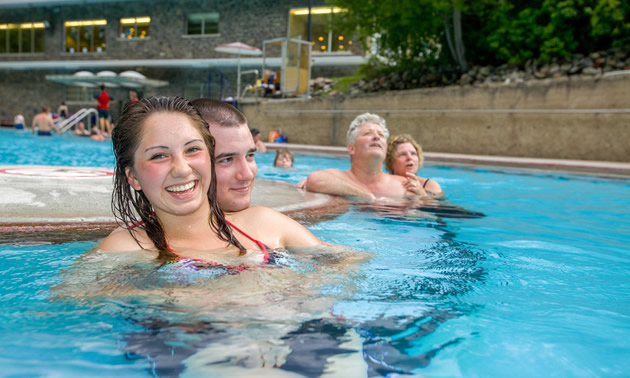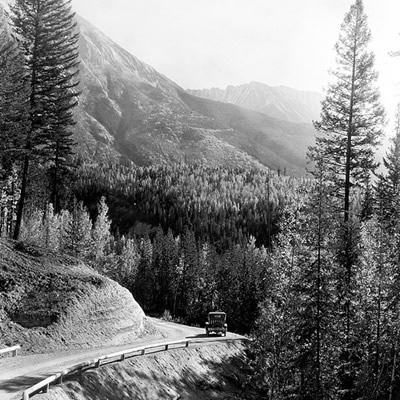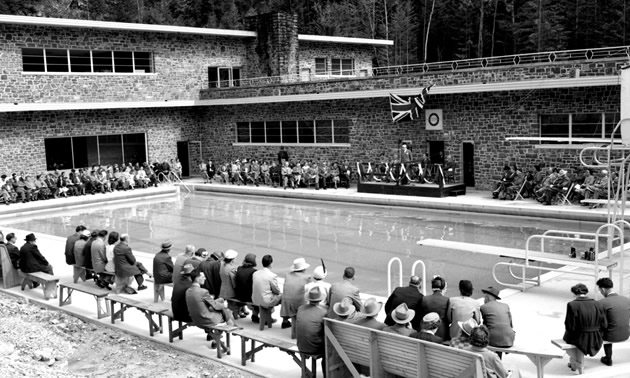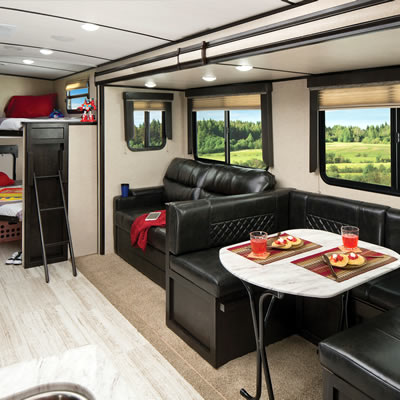Rejuvenate in Radium Hot Spring’s rich history
This gem is part of Kootenay National Park and has been a special place for Indigenous peoples and now tourists

The East Kootenay is home to a plethora of magical hot springs, both natural and developed. People from all over the world flock to these springs to heal, to feel rejuvenated or simply to relax and enjoy. Canada’s biggest hot springs pool, Radium Hot Springs, is located at the incredibly beautiful south entrance to Kootenay National Park in the Village of Radium Hot Springs.
The Radium Hot Springs facility is a federally designated heritage building. Constructed between 1949 and 1951, it was the first major post-war building project in the western parks. Over half of all visitors to Kootenay National Park also visit the Radium Hot Springs pools. After the hot spring was expropriated from Roland Stuart when the park was formed in the early 1920s, the history and visitation of the two have always been closely tied together.
According to Parks Canada, Radium Hot Springs is a First Nations spiritual site. It was used as a source of rejuvenation and healing by Indigenous people travelling through the mountain passes. Then in 1841, George Simpson, then governor of the Hudson's Bay Company, stopped for a soak in the then gravel pool. By all accounts he was the first recorded "tourist" in the region. By the late 1800s permanent settlers began arriving in the valley and the hot springs became more popular.
Renaming the mineral waters
In 1890, Stuart purchased the area around Radium Hot Springs, including the hot springs themselves, for $160. He originally intended to bottle the water for its perceived mineral properties. Then in the early 1900s, water tests conducted at McGill University found traces of radon in the water, leading the hot springs to be renamed Radium Hot Springs. By 1914, Stuart had raised enough money to build a concrete bathing pool, log bath house, small store and caretakers cabin. (Note: The radon in the water is minimal and not dangerous to humans.)
Kootenay National Park was established in 1920 around plans for a motor road that connected the Windermere Valley with Banff and Calgary. By 1922, the Government of Canada had assumed ownership of Radium Hot Springs and included it in the newly established national park. The Banff-Windermere Highway opened in 1923, and circle tour routes from the U.S. and Alberta that included driving the newly constructed highway soon became popular.

Today, you can drive from Banff to Radium Hot Springs in two hours. You can search “Explore Kootenay” on iTunes or Google Play to download Parks Canada’s driving tour app and enjoy a guided tour along the way! In the 1920s, however, the drive took a full day, and without the benefit of modern suspension, visitors felt every bump on the gravel highway.
In 1927, a new bathhouse was constructed to replace the log structure. This building burnt down in the late 1940s and was replaced with the current aquacourt facility in 1951. The aquacourt building was recognized as a classified federal heritage building in 1994.

Updating the facility
According to Karin Smith, marketing co-ordinator for Canadian Rockies Hot Springs, Parks Canada, construction is currently underway at Radium Hot Springs. The Government of Canada is investing $5.7 million on deferred maintenance including updating the café and gift shop space, repairing the roof top deck/day-use area, updating mechanical and electrical systems in the aquacourt building and fixing the pedestrian access ramp.
Smith said once the project is complete, this will be the single largest investment in the hot springs to date and will ensure it remains available for current and future generations. The hot springs remains open and visitors should expect visible and audible signs of constructions. (Visitors are encouraged to check www.hotsprings.ca for any changes to the hours of operation.)
"Radium Hot Springs has long been a treasured destination for travellers,” said Smith. “The soothing mineral waters and warm, relaxing atmosphere continue to attract generations of visitors from around the world. Radium Hot Springs is open year-round and is the largest of three facilities operated by Parks Canada. Known for its beautiful scenery, on-site spa, wildlife-watching opportunities and nearby family-friendly hiking trails, this heritage facility also features a cooler swimming pool that is popular with the kids on a hot summer's day.”
To find out more about the history of this special area in southeastern B.C., you can also check out Radium Hot Spring’s small exhibit about Radium’s history in the hot springs aquacourt, and there’s also an exhibit about prescribed fire and First Peoples in the Kootenay National Park Visitor Centre.






